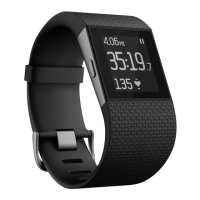9
Measuring heart rate
When your heart beats, your capillaries expand and contract based on blood volume
changes. PurePulse™ LED lights on your Fitbit Surge reflect onto the skin to detect
blood volume changes, and finely-tuned algorithms are applied to measure heart rate
automatically and continuously.
When viewing the Clock, swipe to display your current beats per minute and heart
rate zone.
Default heart rate zones
Heart rate zones can help you optimize your workout by targeting different training
intensities. Your zones are calculated based on a percentage of your estimated
maximum heart rate. Fitbit calculates your maximum heart rate with the common
formula of 220 minus your age.
To quickly determine what zone you’re in, take a look at the heart icon:
Out of zone Fat burn Cardio Peak
• When you’re out of zone, which means you’re below 50% of maximum, your
heart rate may be elevated but not enough to be considered exercise.
• Fat Burn zone, which means your heart rate is 50% to 69% of maximum, is the
low-to-medium intensity exercise zone and may be a good place to start for
those new to exercise. It’s called the fat burn zone because a higher
percentage of calories are burned from fat, but the total calorie burn rate is
lower.
• Cardio zone, which means your heart rate is 70% to 84% of maximum, is the
medium-to-high intensity exercise zone. In this zone you’re pushing yourself
but not straining. For most people this is the exercise zone to target.
• Peak zone, which means your heart rate is greater than 85% of maximum, is
the high-intensity exercise zone. The peak zone is for short intense sessions
that improve performance and speed.
At any time you can check your dashboard to see the amount of time you’ve
spent in each zone.

